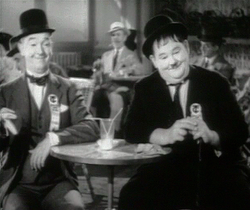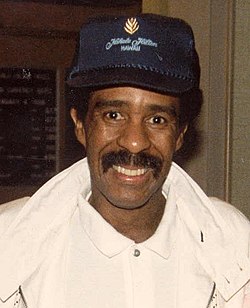Male–male relationships
A buddy film portrays the pairing of two people, often the same sex, frequently men. A friendship between the two people is the key relationship in a buddy film. The two people often come from different backgrounds or have different personalities, and they tend to misunderstand one another. Through the events of the buddy film, they gain a stronger friendship and mutual respect. Buddy films often deal with crises of masculinity. American Masculinities: A Historical Encyclopedia explains, "[Buddy films] offer male movie-going audiences an opportunity to indulge in a form of male bonding and behavior usually discouraged by social constraints." [1] Ira Konigsberg wrote in The Complete Film Dictionary, "Such films extol the virtues of male comradeship and relegate male–female relationships to a subsidiary position." [2]
History
Ancient archetype
Buddy literature dates back as early as the ancient Mesopotamian Epic of Gilgamesh , which details the combat and subsequent bonding of Gilgamesh and Enkidu, followed by their heroic adventures together. Gardner and Maier consider it to be possibly the first of "friendship literature," which would later feature prominently in Greek and Roman works. [4]
1960s to 1970s: Responses to feminism and society
Throughout the 1960s and the 1970s, the feminist movement and "a widespread questioning" of social institutions influenced buddy films. The films explored male friendships more dramatically and encouraged individualism—particularly to be free from women and society. [1] Critics such as Molly Haskell and Robin Wood saw the decades' films as "a backlash from the feminist movement." [8] Philippa Gates wrote: "To punish women for their desire for equality, the buddy film pushes them out of the center of the narrative ... By making both protagonists men, the central issue of the film becomes the growth and development of their friendship. Women as potential love interests are thus eliminated from the narrative space." [9] The buddy films of these decades were also hybridized with road movies. [8] The decades' buddy films included Butch Cassidy and the Sundance Kid (1969), Easy Rider (1969), Midnight Cowboy (1969), Thunderbolt and Lightfoot (1974), and Dog Day Afternoon (1975). [1] The Los Angeles Times said films like Scarecrow (1973) and All the President's Men (1976) reflected the "paranoia and alienation" felt in the era. [5] Beyond Hollywood, a notable buddy road movie of that era was the Bollywood "Curry Western" film Sholay (1975), [10] which was the highest-grossing Indian film of all time. [11] [12]
Biracial buddy films emerged in the 1970s and 1980s; Richard Pryor and Gene Wilder initiated the movement with Silver Streak (1976) and Stir Crazy (1980). Eddie Murphy was a key actor in biracial buddy films, starring in 48 Hours (1982) with Nick Nolte and in Trading Places (1983) with Dan Aykroyd. [13] Throughout the 1980s, the individual roles in biracial buddy films are reversed. The "racial other... is too civilized" while the white man "is equipped for survival in... the urban landscape". [14]
1990s: New approaches to the genre
In the early 1990s, the masculine figure in films became more sensitive, and some buddy films "contemplated a masculinity that required sensitive relations between men". Such films included The Fisher King (1991) and The Shawshank Redemption (1994). The decade also saw new approaches to the genre. The 1991 film Thelma & Louise featured a female pairing of Geena Davis and Susan Sarandon, and the 1993 film The Pelican Brief featured a male–female platonic pairing of Julia Roberts and Denzel Washington. The 1998 film Rush Hour featured a nonwhite male pairing of Jackie Chan and Chris Tucker, [1] which the Los Angeles Times said symbolized color blindness in American cinema. [5]
Biracial buddy films continued in the 1990s and 2000s and were combined with different genres, such as White Men Can't Jump (1992), Bulletproof (1996), Gridlock'd (1997), National Security (2003) and The Bucket List (2007). [1] [14] [17]
Also in the 1990s and 2000s, John Woo's Hollywood films imported the wuxia "themes of loyalty and trust" from his previous Hong Kong-produced films to create different takes on male bonding. Kin–Yan Szeto writes in The Martial Arts Cinema of the Chinese Diaspora, "[In] his third Hollywood film, Face/Off ... Woo manages to deploy and politicize themes of homosociality with the possibility of contesting hegemonic masculinity that consolidates kinship and family." Woo's 2001 World War II film Windtalkers depicted two buddy pairs, with each pair indicating inequality through ethnicity (white American soldiers protecting Navajo code talkers but ready to kill the talkers to protect the code). Szeto explains, "Woo uses the twin buddy pairs to explore the shifting meanings and multiple possibilities in interracial bonding, rather than simply recuperating and empowering dominant positions for white heterosexual men." [18]
Television series
Lethal Weapon was adapted into a television series which ran from 2016 to 2019. [68] The 2021 series The Falcon and the Winter Soldier has many of the features of the buddy film genre, and is influenced by films like 48 Hrs., The Defiant Ones, Lethal Weapon and Rush Hour. [69] [17] Other examples include Hardcastle and McCormick , in which a retired judge and his last defendant follow up on cases that were dismissed due to technicalities; CHiPs , the adventures of two California Highway Patrol motorcycle officers; and Voyagers! , in which a member of a league of time travelers and a boy travel through time repairing errors in world history.
In 2018, an original anime production A Place Further than the Universe aired. It comprises four girls with contrasting personalities and life background meeting together to go to Antarctica. [70]
This page is based on this
Wikipedia article Text is available under the
CC BY-SA 4.0 license; additional terms may apply.
Images, videos and audio are available under their respective licenses.


